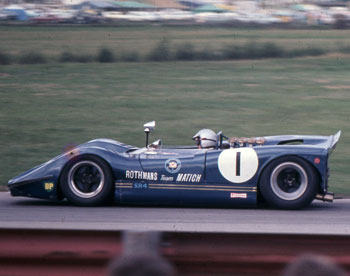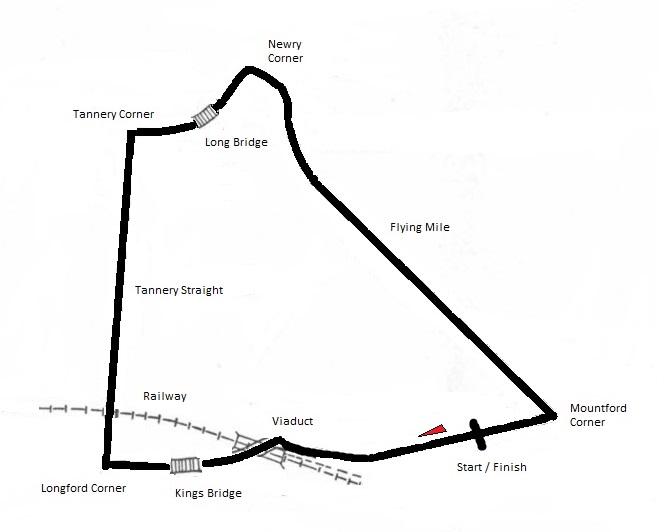|
Frank Matich
Frank Matich (25 January 193511 May 2015) was an Australian racing car driver. A highly successful motor racing competitor in the 1960s and 1970s, Matich built his own range of Matich sports cars and open wheel cars, mainly to support his own career, but some cars found success with other drivers. In these and other makes he won five Tasman Series races, two Australian Grands Prix, the 1972 Australian Drivers' Championship and a number of other Australian motor racing titles. In April 1970, Frank Matich was appointed as a Director of Lambretta (Australasia) Pty Ltd, and was to assemble McLaren racing cars in the Lambretta site in Artarmon, Sydney. Matich, who suffered major electrical burns in a boating accident in 1973, retired from racing in 1974 in order to spend more time with his family and his business. His son Kris Matich became a leading Formula Ford driver in Sydney Sydney ( ) is the capital city of the state of New South Wales, and the most populous city in bo ... [...More Info...] [...Related Items...] OR: [Wikipedia] [Google] [Baidu] |
Tasman Series
The Tasman Series (formally the Tasman Championship for Drivers)Tasman Championship for Drivers, CAMS Manual of Motor Sport with National Competition Rules 1974, pages 80 to 83 was a motor racing competition held annually from 1964 to 1975 over a series of races in New Zealand and Australia. It was named after the Tasman Sea which lies between the two countries. The Tasman Series races were held in January through to late February or early March of each year, during the Formula One off season, taking advantage of winter in the Northern Hemisphere to attract many top drivers to summer in the south. The Tasman Cup was the permanent trophy awarded to the winning driver. History The Tasman initially started in 1960 as a series of unrelated races between Australia and New Zealand. In 1964 it was renamed Tasman Cup. Until 1969, the Tasman Formula specified open-wheel single-seater racing cars similar to Formula One cars, yet retaining F1 engine rules that were in effect until 1960. ... [...More Info...] [...Related Items...] OR: [Wikipedia] [Google] [Baidu] |
Open Wheel
An open-wheel single-seater (often known as formula car) is a car with the wheels outside the car's main body, and usually having only one seat. Open-wheel cars contrast with street cars, sports cars, stock cars, and touring cars, which have their wheels below the body or inside fenders. Open-wheel cars are built both for road racing and oval track racing. Street-legal open-wheel cars, such as the Ariel Atom, are scarce as they are often impractical for everyday use. History American racecar driver and constructor Ray Harroun was an early pioneer of the concept of a lightweight single-seater, open-wheel "monoposto" racecar. After working as a mechanic in the automotive industry, Harroun began competitive professional racing in 1906, winning the AAA National Championship in 1910. He was then hired by the Marmon Motor Car Company as chief engineer, charged with building a racecar intended to race at the first Indianapolis 500, which he went on to win. He developed a revolutionary ... [...More Info...] [...Related Items...] OR: [Wikipedia] [Google] [Baidu] |
Elfin Sports Cars
Elfin Sports Cars Pty Ltd (formerly known as Elfin Sports Cars) is an Australian car manufacturer company that was founded by Garrie Cooper. It has been an Australian manufacturer of sports cars and motor racing cars since 1959. Elfin Sports Cars is currently owned by the estate of former British racing driver Tom Walkinshaw, through his company Walkinshaw Performance which also owns Holden Special Vehicles. It was previously owned by businessmen and historic racing enthusiasts Bill Hemming and Nick Kovatch (who remains as technical director) who purchased it in 1998. Elfin is the oldest continuous sports car maker in Australia and one of the most successful with 29 championships and major Grand Prix titles. The original factory was located at Conmurra Avenue, Edwardstown in suburban Adelaide, South Australia. The company is currently located at Braeside, a suburb of Melbourne, Australia. History The company was founded in South Australia as Elfin Sports Cars in October 1959 b ... [...More Info...] [...Related Items...] OR: [Wikipedia] [Google] [Baidu] |
1962 Australian Formula Junior Championship
The 1962 Australian Formula Junior Championship was a CAMS sanctioned motor racing title open to Formula Junior racing cars. The championship was contested over a single 30 lap, 60 km race, staged at the Catalina Park circuit at Katoomba in New South Wales,History of Formula Junior events in Australia during period 1960 - 1963, www.australianformulajunior.com Retrieved on 19 May 2012 on 28 October 1962.Ray Simpson, Aussie Car won Junior title, Modern Motor, January 1963, pages 26-27 The title, which was the inaugural |
1961 Australian Tourist Trophy
The 1961 Australian Tourist Trophy was a motor race open to Sports Cars and invited GT Cars,''Event 3, 1961 Australian Tourist Trophy'', Official Programme, Mount Panorama, Bathurst, Sunday 1 October 1961, page 21 staged at the Mount Panorama Circuit near Bathurst in New South Wales, Australia on 1 October 1961.''Driver untroubled in trophy race win'', Sydney Morning Herald, Monday, 2 October 1961, page 6 The race was organised by the Australian Racing Drivers Club.Mike Kable, Stillwell Unchallenged Winner of Australian Tourist Trophy, Sports Car World, December 1961, pages 50 to 53 It was the fifth in a sequence of annual Australian Tourist Trophy races, and was recognized by the Confederation of Australian Motor Sport as the Australian championship for sports cars.''National Titles'', 1961 CAMS Manual of Motor Sport, page 53 The race was won by Bib Stillwell driving a Cooper Monaco. Results {, class="wikitable" generated with :de:Wikipedia:Helferlein/VBA-Macro for EXCEL ta ... [...More Info...] [...Related Items...] OR: [Wikipedia] [Google] [Baidu] |
1960 Australian Tourist Trophy
The 1960 Australian Tourist Trophy was a motor race for sports cars, staged at the Longford Circuit in Tasmania, Australia on Monday, 7 March 1960.Longford Races, Australian Motor Sports, March 1960, pages 108–110 & 118 It was the fourth in a sequence of annual Australian Tourist Trophy races, with each of these being recognized by the Confederation of Australian Motor Sport as the Australian Championship for sports cars.''National Titles'', 1961 CAMS Manual of Motor Sport, page 53 The race was won by Derek Jolly driving a Lotus 15 The Lotus 15 is a front-engine sports racing car designed by Colin Chapman of Lotus, built from 1958 until 1960. Series 1 The 15 is a two-seater, front-engine, rear wheel drive sports racer with an aluminium body over a space frame configuratio .... Results Notes * Attendance: 12,000 * Pole position: Ron Phillips * Starters: 22 * Race distance: 24 laps – 108 miles * Race time of winning car: 69 minutes 20 seconds * Fastest lap: Derek Jolly ... [...More Info...] [...Related Items...] OR: [Wikipedia] [Google] [Baidu] |
Jaguar D-Type
The Jaguar D-Type is a sports racing car that was produced by Jaguar Cars Ltd. between 1954 and 1957. Designed specifically to win the Le Mans 24-hour race, it shared the straight-6 XK engine and many mechanical components with its C-Type predecessor. Its structure, however, was radically different, with innovative monocoque construction and slippery aerodynamics that integrated aviation technology, including in some examples a distinctive vertical stabilizer. Engine displacement began at 3.4 litres, was enlarged to 3.8 L in 1957, and reduced to 3.0 L in 1958 when Le Mans rules limited engines for sports racing cars to that maximum. D-Types won Le Mans in 1955, 1956 and 1957. After Jaguar temporarily retired from racing as a factory team, the company offered the remaining unfinished D-Types as street-legal XKSS versions, whose perfunctory road-going equipment made them eligible for production sports car races in America. In 1957 25 of these cars were in various stages ... [...More Info...] [...Related Items...] OR: [Wikipedia] [Google] [Baidu] |
1959 Australian Drivers' Championship
The 1959 Australian Drivers Championship was a CAMS sanctioned motor racing title for drivers of Formula Libre cars. The championship winner was awarded the 1959 CAMS Gold Star. The series was won by Victorian racer Len Lukey driving his Cooper T45 Climax and in the opening round of the series his own much modified Cooper T23 which was known as the Lukey-Bristol. Lukey was one of only a few drivers who attempted to complete the gruelling twelve race schedule, the longest in ADC history. Lukey finished just two points ahead of his season long rival, Alec Mildren from the ACT (Cooper-Climax). Stan Jones was third in the championship, using four different cars over the course of the series. Race victories were shared around with Mildren taking three wins. Lukey, Jones and Bill Patterson each took two wins, with single victories going to Jack Brabham, Bib Stillwell and New Zealand Maserati 250F racer Ross Jensen. Calendar The title, which was the third Australian Drivers' Champi ... [...More Info...] [...Related Items...] OR: [Wikipedia] [Google] [Baidu] |
Jaguar C-Type
The Jaguar C-Type (officially called the Jaguar XK120-C) is a racing sports car built by Jaguar and sold from 1951 to 1953. The "C" stands for "competition". The car combined the running gear of the contemporary, road-proven XK120, with a lightweight tubular frame designed by Jaguar Chief Engineer William Heynes, and an aerodynamic aluminium body, jointly developed by William Heynes, R J (Bob) Knight and later Malcolm Sayer. A total of 53 C-Types were built, 43 of which were sold to private owners, mainly in the US. Specification The road-going XK120’s 3.4-litre twin-cam, straight-6 engine produced between 160 and . The C-Type version was originally tuned to around . The early C-Types were fitted with SU carburettors and drum brakes. Later C-Types, produced from mid 1953, were more powerful, using triple twin-choke Weber carburettors and high-lift camshafts. They were also lighter, and braking performance was improved by using disc brakes on all four wheels. The lig ... [...More Info...] [...Related Items...] OR: [Wikipedia] [Google] [Baidu] |
1958 Australian Tourist Trophy
The 1958 Australian Tourist Trophy was a 100-mile motor race for sports cars, staged at the Mount Panorama Circuit near Bathurst in New South Wales, Australia on 6 October 1958.David McKay, ''Davison again'', Modern Motor, December 1958, pages 18, 19, 69 & 70 It was the second in a sequence of annual Australian Tourist Trophy races, each of which was recognised by the Confederation of Australian Motor Sport as the Australian Championship for sports cars.National Titles, 1961 CAMS Manual of Motor Sport, page 53 The race was won by David McKay driving an Aston Martin DB3S The Aston Martin DB3S is a sports racing car that was built by Aston Martin. Following the failure of the heavy and uncompetitive Aston Martin DB3 designed by Eberan Eberhorst; William Watson, employed as Eberhorst's assistant, presented an alt ....John B Blanden, Historic Racing Cars in Australia, 1979 Class Structure Cars competed in six classes based on engine capacity:''Wind sends driver crashing at 12 ... [...More Info...] [...Related Items...] OR: [Wikipedia] [Google] [Baidu] |







